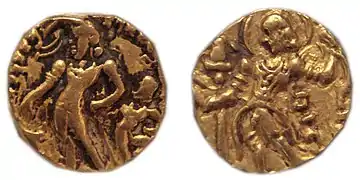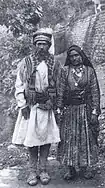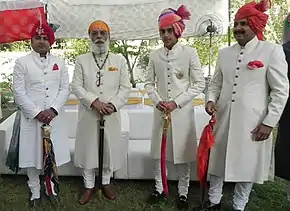Achkan
Achkan (Hindi: अचकन) also known as Baghal bandi is a knee length jacket worn by men in the Indian subcontinent much like the Angarkha.
Etymology
The word achkan is derived from Angarkha (Sanskrit: अंगरक्षक, anga-rakshaka 'body protector').[1] The angarkha was worn in various parts of the Indian subcontinent, while the basic cut remained the same, styles and lengths varied from region to region.[2]
History

Greeks mention achkan and gown like dresses worn by men and women all the way during mauryan period, The earliest iconographic evidence for such a dress appears in sculptures and rock relief in Iran as well as paintings from Parthian Empire. The earliest iconographic evidence in India is from Kushan Empire which was founded by Central Asian nomadic tribe called Yeuzhi by the Chinese. However, since the Yeuzhi Kushans adopted many aspects of their culture from Greco-Parthian Kingdom, therefore its plausible that this dress is the legacy of Parthian culture. It can be distinguished from the Sherwani through various aspects, particularly the front opening. Achkan traditionally has side-opening tied with strings, this style of opening is known as baghal bandi but frontal opening were not uncommon, similar to Angarkha. While sherwani always has straight frontal opening, due to its function as outer-coat. Achkan, like Angarkha was traditionally worn with sash known as patka, kamarband or dora wrapped around the waist to keep the entire costume in place. While sherwani was traditionally worn as decorative outer-coat for special occasions during medieval times. Achkan is always worn with either dhoti or churidar. Achkan is made from various fabrics for both formal and informal occasions, it features traditional embroidery like gota and badla. Today, achkan is commonly worn by the grooms during wedding ceremonies or other formal festive occasions in the Indian subcontinent.
There are various regional variations of achkan worn throughout the Indian subcontinent, and are known by regional names such as Daura in Nepal and Northeast India, Angi in Southern India and Chola or Cholu in Indian Himalayas.
Gallery
 Samudragupta depicted with achkan, Gupta Empire
Samudragupta depicted with achkan, Gupta Empire Sculpture depicted with achkan, sash and outer coat, 1st century CE.
Sculpture depicted with achkan, sash and outer coat, 1st century CE. Sculpture depicted with achkan, sash and outer coat, 1st century CE.
Sculpture depicted with achkan, sash and outer coat, 1st century CE. A man dressed in achkan with dora or sash wrapped around the waist.
A man dressed in achkan with dora or sash wrapped around the waist. Display of various styles of achkan and Angarkha worn by men, Delhi textile museum.
Display of various styles of achkan and Angarkha worn by men, Delhi textile museum.
References
- Zaira Mis, Marcel Mis (2001) Asian Costumes and Textiles: From the Bosphorus to Fujiama
- Kumar, Ritu (2006) Costumes and textiles of royal India
